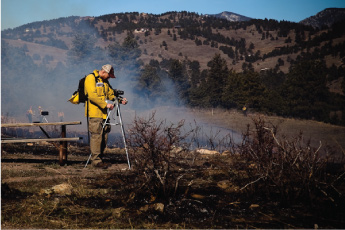A how-to on video for park and recreation pros just like you.
Anybody can learn to do it.
These encouraging words from Topher Downham of Boulder’s Open Space and Mountain Parks about creating videos capped my February Parks & Recreation Magazine article.
If you’re someone with a drive to learn and take a realistic look at the road ahead, you can avoid many a wrong turn. Not all of them, mind you.
As a former newspaper writer and magazine editor, I’ve certainly gone off track in my early video creations. Equipment has failed me, or I’ve failed it. At times I’ve felt over the tips of my skis. I’ve also exulted in feeling completely on track in working for Jeffco Open Space in this dynamic medium.

Will Lebzelter of Jeffco Open Space films a controlled
burn at White Ranch Park, outside Golden, Colorado.
If you’re new to creating video, first consider inroads. Set still images to music in PowerPoint to tell a story, play around with Prezi, apply the “Ken Burns effect” to your pictures in iMovie. Most of us have plenty of good pictures on hand. Capturing good video is less forgiving than taking photos.
Instagram provides a great bridge from photos to video. With the Flipstagram app, users can sequence a virtually unlimited number of stills into a 15-second video. Instagram also allows you to upload 15 seconds of video. We’re using our own Instagram account to highlight beautiful pictures of our parks and enjoy those precious 15 seconds of frame. Casey Neistat provides inspiration in his “Instagram i love you” video.
Once you’ve identified a project that would serve your organization well in a longer video format, keep these tools and resources in mind.
Goal
What do you want your video to accomplish? Don’t start until you can state it in a few words with conviction.
Along the way, video opportunities may present when you don’t have a video in mind. By all means, take footage. Store it in a safe place you won’t forget and keep it in mind for future projects.
Messages
The most popular videos on YouTube average 2 minutes. If you try to cram more than three key messages in your video, no one is likely to remember one.
Storyboard
A storyboard represents your ideas as individual frames in the video. It’s a roadmap of the people, places and props required that reflects different camera vantages and techniques. Storyboards don't discriminate against stick figures, only against those who don't use storyboards.
Shot List
Think of it as a shopping list of the footage you want to collect. You don’t want to end up like the guy who ignores his wife’s list and has to trudge back to the grocery store for toilet paper. Nor do you want to have to arrange a re-shoot with your source. Check off shots while you go or before you go.
Camera
Start with what you have. My first video was done on an iPhone. It was about our dog off-leash area. Although the sound isn’t great, the spirit of the park is, helping to make up for some of the technical shortcomings. Smartphones and point-and-shoot cameras with video are fine starts.
HD-SLRs and dedicated video cameras deliver rich footage and are easier to accessorize with lights and mics. Don’t let your technology outstrip your humanity, however. The ability to tell a story is more important than any piece of equipment.
Microphone
There are ways to work around bad video. When it comes to poor audio, though, there are no easy solutions. An external mic will be superior to your camera’s internal mic. Options for park and recreation agencies include hand-held, lavaliere (wired or wireless) or camera-mounted. Keep your ears open and shop around.
Tripod
Being able to stabilize your camera on a tripod, especially a fluid-head model, is great for interviews and panning across landscapes. The camera doesn’t always have to be still, though. Just look at all the intentionally unstable camera techniques used on TV today. To be more agile and mobile in the field, we’ve found a shoulder mount from Cowboy Studio for around $30.
Reflector Kit
Light up faces and prevent harsh shadows.
Editing Software
YouTube now has built-in editing software—great for quick-hit videos. iMovie is a popular introductory software for Mac, iPad and even iPhone. If you decide to move toward advanced editing software such as Premiere, FinalPro or Avid, make sure that your computer is well equipped to handle it.
Angels
We all need ’em. Angels can take the guise of:
- The Chamber of Commerce, which may decide that it wants to showcase the beauty of the local parks system, as it did for the City of Raleigh.
- Community TV Stations that want to feature the natural wonders of your area, as done for the City of Aurora (Co.) Open Space and Parks.
- Local Videographers, such as Colinda de Groen, who’s produced nearly 70 videos pro bono in cooperation with our agency and others for her nonprofit RangeTrackerTV.
- Mentors: Through YouTube tutorials and the wisdom of local talent, you can fill in the gaps of not having an NYU or USC film degree.
- Interns! We’ve been blessed with two talented students, Rylan Rafferty in the fall and Danielle Flick in the spring. Without them, our “There’s More Out Here” video series would not be launching on our newly created YouTube channel, separate from the County’s.
Editor's Note: What kind of videos are you currently using at your parks and rec? Any specific challenges you've encountered? Let us know!
Will Lebzelter is Communications Associate for Jeffco Open Space, carving out time for video where he can. Awash in email, he welcomes phone calls at 303.271.5961. Feel free to unwind your tale of the tape.

